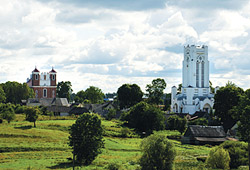History
The story of Šiluva began in 1457, when the local nobleman Petras Simonas Gedgaudas built a church dedicated to the Nativity of Holy Mary and to Saints Peter and Bartholomew. Pilgrims were known to flock there from as far away as neighbouring Prussia for the titular feast of the Blessed Virgin’s birthday.
In the middle of the 16th century, Calvinism took hold in the region of Šiluva. Even so, as long as the Catholic church remained standing, people continued travelling there for its indulgenced feast. Eventually the church was closed and demolished. Around 1569, the last parish priest of Šiluva, Fr Jonas Holubka, took the shrine’s valuables and important documents and buried them nearby.
Later Catholics tried to get back the church property which had been seized by the Calvinists. But legal proceedings to recover the church at Šiluva were unsuccessful as there were no documents proving past Catholic ownership. A breakthrough occurred after the Blessed Virgin Mary’s apparition: the church’s founding documents were rediscovered, and a court decision in 1622 returned the property to the Catholics. A new wooden church quickly arose where the old one had stood, and the indulgenced feast of Šiliniai revived. Soon the church’s picture of Mary with the Child Jesus gained renown because of miracles associated with it. Pope Pius VI gave permission in 1775 to extend the celebration of the titular indulgenced feast from a single day to an ‘octave’, or eight-day solemnity. A new brick church – the current Basilica of the Nativity of the Blessed Virgin Mary - was dedicated in 1786. At the same time, the image of Mary and Jesus, which had long been famous for special graces, was adorned with golden crowns.
Tsarist Russia, which occupied Lithuania during the 19th century, unsuccessfully tried to hinder the traditions of piety at Šiluva. During a period when printing in Lithuanian was abolished, patriotic smugglers would come to the shrine to distribute forbidden literature and prayer books in the Lithuanian language. Šiluva’s titular feast gained particular popularity in independent Lithuania, between the first and second World Wars. A special committee was then set up in Kaunas to organize pilgrimages. Not even the Soviet Union could interrupt Šiluva’s indulgenced feast traditions, although KGB officials did everything they could during the Soviet years to keep pilgrims away. In 1979, for example, the Soviet authorities declared an outbreak of pig plague in the area to justify closing all the roads to Šiluva.
Through all the various foreign occupations, Šiluva remained a centre of attraction for pilgrims. And when independence was regained, its indulgenced feast tradition flourished once again. In 1991, Cardinal Vincentas Sladkevičius and Vytautas Landsbergis, then speaker of the Lithuanian parliament, signed an act at Šiluva consecrating Lithuania to the Blessed Virgin Mary.
Pope John Paul II visited Šiluva on September 7, 1993. The Holy Father prayed in the Apparition Chapel and took part in a celebration of the Liturgy of the Word in the shrine’s Basilica.
During the Šilinės octave in 2003, on the occasion of the 10th anniversary of the Holy Father’s visit, Archbishop Sigitas Tamkevičius blessed the John Paul II House, which lodges seminarians during their preparatory year as well as people attending spiritual retreats at Šiluva. In 2007, the parish of Šiluva commemorated its 550th anniversary.
In 2008, the 400-year jubilee of Mary’s apparition was celebrated with great solemnity. For the occasion, Archishop Tamkevičius declared a Year of Our Lady of Šiluva, the Basilica and the Apparition Chapel were renovated, and the two sanctuaries were joined together by a common square to fulfil at last plans drafted before World War II but later blocked by the Soviet regime. Work also began on a Pilgrim Path that begins in a clearing of the Šiluva pine forest just off the road from Raseiniai and winds 2 km (just over a mile) through the forest to the Apparition Chapel. Along the path there are Stations of the Cross.
Pope Benedict XVI sent Cardinal Joachim Meisner as his special legate for the solemn main events of the 400-year jubilee of Mary’s apparition on September 6-15, 2008. During those days about 150,000 pilgrims visited Šiluva, people from all parts of Lithuania as well as from numerous countries near and far. Very many of them received the Sacrament of Reconciliation, received Holy Communion (56,000 consecrated hosts were distributed) and took advantage of the opportunity to gain the jubilee indulgence. For the first time in history, an ecumenical prayer service was held at Šiluva, including representatives of several Christian confessions.








